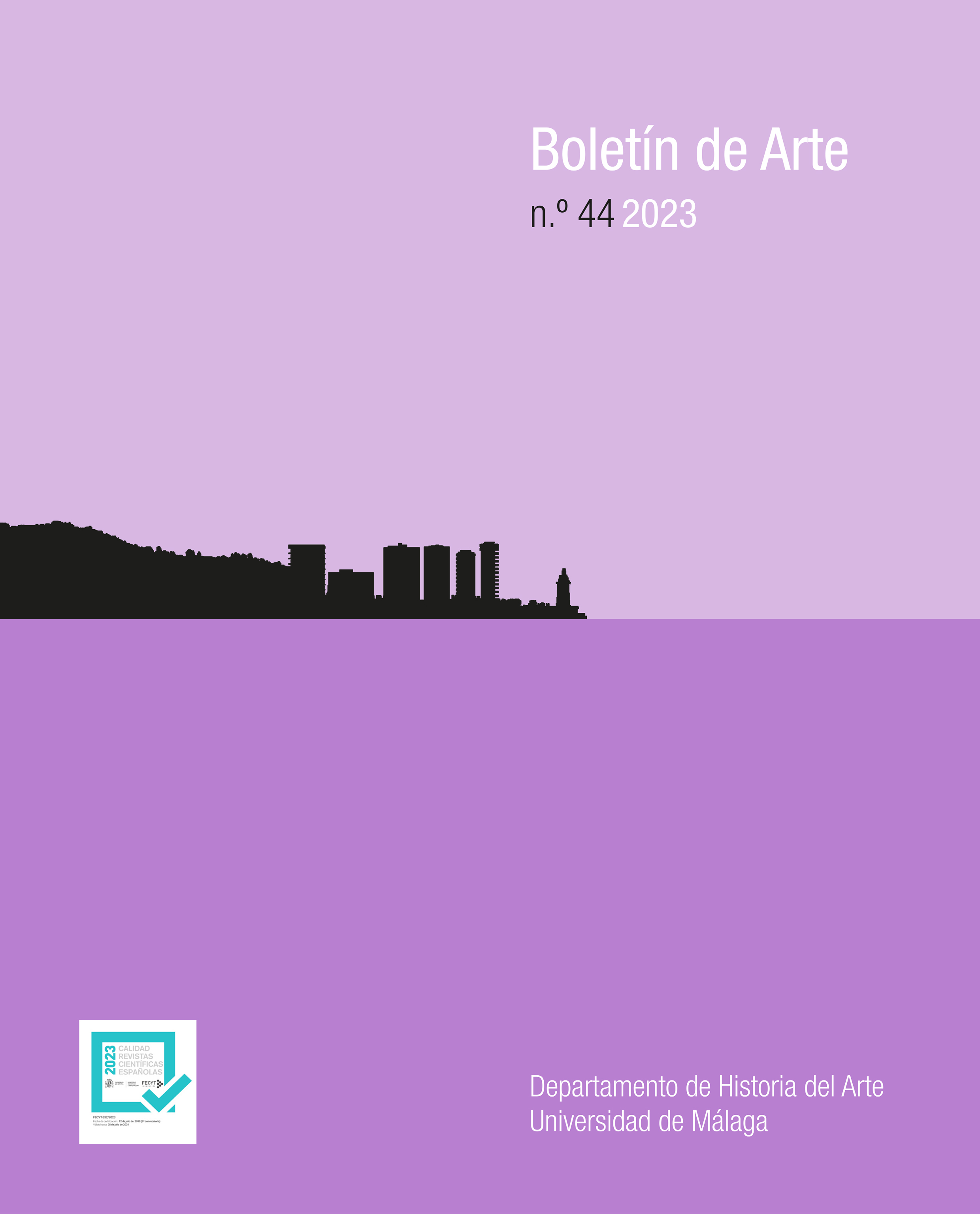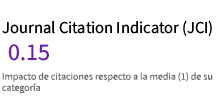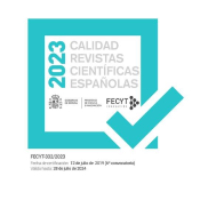The Aesthetic Construction of the Passante in the Cinema
Keywords:
Flânerie, Cinema, Woman, Male gaze, Aura, IconologyAbstract
The figure of the flâneur, the male urban stroller born at the end of the 19th century in European capitals, has had great relevance in modern artistic creation. However, the female equivalent with whom he is usually related, the passante (Baudelaire, 1857), has not received enough attention in cinematographic studies. First, the existence of a «flânerie cinema» will be defended, proposing several examples. Then, from a comparative analysis, it will be discussed how such corpus constructs the figure of the passante or flâneuse, exploring its nineteenth-century literary influences and, also, the series of codes inherited from Visual History (Didi-Huberman, 2015), which aesthetically oppose her to the femme fatale. All this will allow us to demonstrate the series of visual codes cinema operationalizes to materialize the intangible idea of aura, personified through this character (Benjamin, 1939).
Downloads
Metrics
Publication Facts
Reviewer profiles N/A
Author statements
Indexed in
-
—
- Academic society
- N/A
- Publisher
- Universidad de Málaga.
References
ASUNCIÓN SILVA, José (1925/2006), De sobremesa, Cátedra, Madrid.
AUGÉ, Marc (2007), Por una antropología de la movilidad, Gedisa, Barcelona.
BAUDELAIRE, Charles (1857/2018), Las flores del mal (edición bilingüe), Cátedra, Madrid.
BAUDELAIRE, Charles (1863), «Le peintre de la vie moderne», Figaro, 10 année, n.º 916 y 917, noviembre.
BAUMAN, Zygmunt (1994), «Desert espectacular», en TESTER, Keith (comp.), The Flâneur, Routledge, Londres, pp. 138-157.
BENJAMIN, Walter (1921/2018), «Pequeña historia de la fotografía», en IBÁÑEZ, Jordi (ed.), Iluminaciones, Taurus, Madrid, pp. 71-90.
BENJAMIN, Walter (1929/2018), «Para una imagen de Proust», en IBÁÑEZ, Jordi (ed.), Iluminaciones, Taurus, Madrid, pp. 41-54.
BENJAMIN, Walter (1935/2018), «París, capital del siglo XIX», en IBÁÑEZ, Jordi (ed.), Iluminaciones, Taurus, Madrid, pp. 253-268.
BENJAMIN, Walter (1936/2018), «La obra de arte en la época de su reproductibilidad técnica», en IBÁÑEZ, Jordi (ed.), Iluminaciones, Taurus, Madrid, pp. 195-223.
BENJAMIN, Walter (1939/2018), «Sobre algunos temas en Baudelaire», en IBÁÑEZ, Jordi (ed.), Iluminaciones, Taurus, Madrid, pp. 269-306.
BOOZER, Jack (1999), «The lethal femme fatale in the noir tradition», Journal of Film and Video, vol. 51, n.º 3/4, pp. 20-23.
BOURDIEU, Pierre (1998), La domination masculine, Seuil, París.
BRETON, André (1928/1984), Nadja, Seix Barral, Madrid.
BREY, Iris (2020), Le regard féminin. Une révolution à l’écran, Points, París.
BUCK-MORSS, Susan (1986), «The flâneur, the sandwich-man and the whore: the politics of loitering», New German Critique, n.º 39, pp. 99-140.
DIDI-HUBERMAN, Georges (2015), Ninfa fluida, Gallimard, París.
D’SOUZA, Aruna y McDONOUGH, Tom (2008), The Invisible Flâneuse? Gender, Public Space, and Visual Cultural in Nineteenth-century, Manchester University Press, París y Manchester.
DUJARDIN, Édouard (1887/2001), Les lauriers sont coupés, Flammarion, París.
ELKIN, Lauren (2017), Flâneuse: Women Walk the City in Paris, New York, Tokyo, Venice and London, Strauss and Giroux, Nueva York.
ENGELS, Friedrich (1845/1975), «The Condition of the Working Class in England», en Marx/Engels Collected Works: Vol. 4, International Publishers, pp. 295-596.
FADANELLI, Guillermo (2017), Elogio de la vagancia, Debolsillo, Barcelona.
GLEBER, Anke (1999), The Art of Taking a Walk. Flânerie, Literature and Cinema in Weimar Culture, Princeton University Press, Nueva Jersey.
GROSSMAN, Julie (2009), Rethinking the Femme Fatale in Film Noir: Ready for Her Close-Up, Springer.
HANSON, Helen y O’RAWE, Catherine (2010), The Femme Fatale: Images, Histories, Contexts, Springer.
JOYCE, James (1922/2021), Ulises, Cátedra, Madrid.
KÖHN, Eckhardt (1989), Straßenrausch: Flanerie und kleiner Form-Versuch zur Literaturgeschichte des Flâneurs von 1830-1933, Das Arsenal, Berlín.
LACIS, Asja (1971), Revolutionär im Beruf, Regner & Bernhard, Múnich.
LEFEBVRE, Henri (1973/2000), Espace et politique: le droit à la ville II, Anthropos, París.
LEROY, Claude (1999), Le mythe de la passante. De Baudelaire à Mandiargues, Presses Universitaires de France, París.
LIANDRAT-GUIGUES, Suzanne (2018), Paris 1900 de Nicole Vedrès (1947), Kaléidoscope des hours, L’Hartmann, París.
LUCAS, George, KATZ, Gloria, y HUYCK, Willard (1978), American Graffiti: A Screenplay, Grove Press, Nueva York.
MORÁBITO, Fernando (2015), Berlín también se olvida, Sexto Piso, Madrid.
NEUMEYER, Harald (1999), The Flâneur: Konzeptionen der Moderne, Königshausen und Neumann, Würzburg.
OCHOA, Jorge Mario (2013), «El poeta en »De sobremesa« de José Asunción Silva», Thémata. Revista de Filosofía, n.º 47, pp. 205-18.
ORTIZ, Luz Marina (2017), El flâneur en el cine de José Luis Guerín: mirada y percepción del espacio urbano, tesis doctoral, Universidad de Córdoba.
PARKHURST, Priscilla (1994), «Flâneur on and off the streets of Paris», en TESTER, Keith, The Flâneur, Routledge, Londres, pp. 22-43.
PARSONS, Deborah (2006), Streetwalking the Metropolis: Women, the City and Modernity, Oxford University Press, Oxford.
PERRATON, Charles y JOST, François (2003), Un nouvel art de voir la ville et de faire du cinéma, L’Harmattan, París.
PESSOA, Fernando (1987), Sobre literatura y arte, Alianza, Madrid.
POE, Edgar Allan (1840), «The man of the crowd». En: <https://poestories.com/read/manofthecrowd> (fecha de consulta: 01-12-2022).
BENJAMIN, Walter y QUINCEY, Thomas de (1821/2000), «Confessions of an English Opium-Eater», en LINDOP, Grevel (ed.), Works of Thomas De Quincey, vol. II, Pickering & Chatto, Manchester.
SCHÜRMANN, Michael (2009), Paris Movie Walks, The Intrepid Traveler, Branford.
SEVERIN, Rüdiger (1988), Spuren des Flâneurs in deutschsprachiger Prosa, Peter Lang Verlag, Frankfurt/Main.
SHIELDS, Rob (1994), «Fancy footworks: Walter Benjamin’s notes on flânerie», en TESTER, Keith, The Flâneur, Routledge, Londres, pp. 61-80.
SMITH, Frances (2018), «Smoke gets in your eyes: re-reading gender in the nostalgia film», Quarterly Review of Film and Video, vol. 35, n.º 5, pp. 463-487.
TILLER, Elizabeth (2015), Women Walking: The Flâneuse and Urban Tourist in Cinema, tesis doctoral, University of Stirling.
TRUFFAUT, François (1966/2019), El cine según Hitchcock, Alianza Editorial, Madrid.
VEDRÈS, Nicole (1945), Images du cinéma français, Éditions du Chêne, París.
VENTURA, Lourdes (2000), La tiranía de la belleza, Plaza & Janés Editores, Barcelona.
VÍÑEZ, Antonia y VÍÑEZ, Inmaculada (2021), «La ‘donna angelicata’ o la deshumanización de la mujer: aproximación al concepto de musa en el dolce stil novo», Raudem. Revista de estudios de las mujeres, n.º 9 (1), pp. 162-175.
WARBURG, Aby (1888-1906), Botticelli, Warburg Institute Archive III.39-1-5, Londres.
WILSON, Elizabeth (1992), «The Invisible Flâneur», New Left Review, n.º 191, pp. 90-110.
WOLFF, Janet (1985), «The Invisible Flâneuse. Women and the Literature of Modernity», Theory Culture Society, n.º 2, pp. 37-46.
WOOLF, Virginia (1925/1960), Mrs. Dalloway, Brace & World, Londres.
Downloads
Published
How to Cite
Issue
Section
License
Copyright (c) 2023 Isabel Argüelles Rozada

This work is licensed under a Creative Commons Attribution-NonCommercial-ShareAlike 4.0 International License.
Todos los contenidos publicados en la revista Boletín de Arte están sujetos a la licencia Creative Commons Reconocimento-NoComercia-Compartirigual 4.0 cuyo texto completo puede consultar en <http://creativecommons.org/licenses/by-nc-sa/4.0>

Los/as autores/as cuyas contribuciones sean aceptadas para su publicación en esta revista conservarán el derecho no exclusivo de utilizar sus contribuciones con fines académicos, de investigación y educativos, incluyendo el auto-archivo o depósito en repositorios de acceso abierto de cualquier tipo.
La edición electrónica de esta revista esta editada por la Editorial de la Universidad de Málaga (UmaEditorial), siendo necesario citar la procedencia en cualquier reproducción parcial o total.








4.png)
